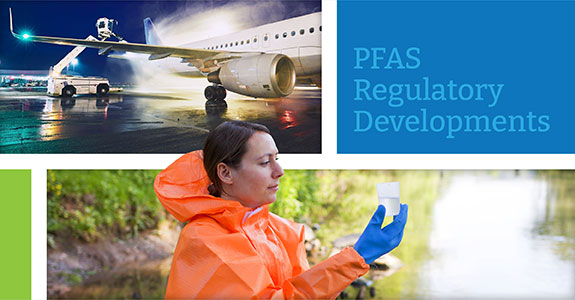
PFAS Regulatory Developments: Concerns, Employee Safety and Community Impact – What you need to know to stay ahead of the curve
March 4, 2022
By: Angela Perez, PhD; CIH
Part 1 of a special, four-blog series
As if 2021 wasn’t challenging enough because of the COVID pandemic, there were multiple (and often confusing) developments in the PFAS regulation landscape. Developments that stand to impact regulations, litigation, exposures, biomonitoring, safety programs, and risk communications.
The number of federally proposed or impending regulations surrounding PFAS is staggering and is compounded by differing PFAS regulations by state. Just staying current on federal and state regulatory updates is a challenge for even the most dedicated stakeholder.
What’s going on, and what do I need to be aware of?
It’s hard to capture every development and mention of PFAS in the regulatory, industry, and lay-press media, but here are some of the most conspicuous or impactful developments from the US EPA:
- Released a plan to conduct the Fifth Unregulated Contaminant Monitoring Ruleto monitor for 29 distinct PFAS in drinking waters nationally.
- Stated intent to publish drinking water standards for PFOA and PFOS
- Developed policy for review of new PFAS chemicals entering commerce under TSCA
- Completed a toxicity assessment for PFBS, PFBA, and GenX
- Released the preliminary Toxics Release Inventoryfor PFAS
- Developed a national PFAS Testing Strategy in June, 2021 & convened a PFAS Science Advisory Board initiated rulemaking for four PFAS chemicals under Resource Conservation and Recovery Act (RCRA)
- Restarted the process to designate PFOA and PFOS as hazardous substances, which will help define the number and location of PFOA and PFOS releases.
The designation PFOA and PFOS as a hazardous substance under the Comprehensive Environmental Response, Compensation, and Liability Act (CERCLA) could substantially impact existing and new cleanup sites. Site owners and responsible parties who release PFOA or PFAS, and possibly other PFAS chemicals will be obligated to report releases, quantify the location and amounts released to stakeholders, and may be liable for partial or total cleanup. Regulatory changes may also delay cleanup and add significant analytical costs for companies who need to evaluate PFAS in various media prior to releases of any kind to waste streams.
The designation of PFAS as hazardous substances has not yet been ratified at a federal level. However, several states (e.g., Washington DOE) have enacted Public Health Goals for surface and drinking waters and cleanup standards – several that incorporate federal hazardous substances lists, ensuring that the impending PFAS regulations will extend beyond federally designated cleanup sites.
Staying up-to-date with the federal and state PFAS regulatory processes will help to inform a company today as to how to avoid pitfalls tomorrow. For example, materials or ingredients elimination and/or substitution to avoid downstream liability. Or installing or contracting with the proper PFAS removal technologies early to avoid paying a premium for when these resources become scarce due to very high demand.
How can I protect my workforce from unintentional exposures to PFAS?
Development of a PFAS safety program for companies who manufacture, process, or move PFAS products is a critical step to comply with new state and federal regulations for PFAS. If you currently manufacture, process, or transport PFAS-containing products, there are early efforts that can help you avoid downstream liabilities.
Operational management of PFAS may seem arbitrary now but will have a large impact in later claims of exposure and personal injury. For example, development and documentation of a job safety analysis for specific work activities where exposures may occur or development of safe work method statements, handling and hygiene training modules, and laundry programs will all be extraordinarily useful to assess potential occupational exposures to PFAS. Risk communication with employees is also important to inform the workforce that the company is aware of the issues surrounding PFAS and that the company prioritizes the health and safety of its workers.
What should I do if my organization has PFAS litigation claims against them?
This is one area you can’t go it alone. You need a trusted partner in the legal process. As a toxicologist and certified industrial hygienist my responsibilities are to aid clients in understanding how to quantify past or current chemical exposures – including the dose, duration, and frequency, and to translate what these exposures may mean in terms of potential risk to human health. A toxicologist can help you understand disease causation or provide an analysis on risk of harm and can provide guidance on the appropriate use of epidemiological and animal toxicology data.
Get informed now. Learn more about what’s coming and how you can prepare.
I’m excited to be a panelist on our upcoming PFAS focused webinar where I’ll be discussing this topic alongside some other experts from the Montrose family. Join us to learn more about what’s coming up in the PFAS landscape, what you need to know, and where you can find answers to your questions.
The 2022 PFAS Crystal Ball: What’s Coming, and How You Can Be Ready
A Blog Series and an Informative Webinar
- Part 1: PFAS Regulatory Developments: Concerns, Employee Safety and Community Impact:
What You Need to Know to Stay Ahead of The Curve - Part 2: Current and Future Requirements in PFAS Compliance, Assessment and Remediation:
What You Need to Know and Why - Part 3: PFAS: Regulatory Constraints from Both an Analytical Methodology and Regulatory Perspective
- Part 4: PFAS Remediation: Fundamental Challenges for the Short and Long Term
 Angela Perez, Ph.D., CIH – Senior Toxicologist, CTEH Panelist
Angela Perez, Ph.D., CIH – Senior Toxicologist, CTEH Panelist
Dr. Perez is a Senior Toxicologist, specializing in human health risk assessment of environmental, occupational, and consumer product settings. She has over 15 years of experience in the field of toxicology and has over 40 published manuscripts and abstracts on the topics of conducting and managing studies involving historical exposure reconstruction, applied toxicology, chemical exposure assessment, and human health risk assessment. Her research experience includes investigating assessing exposure to and the potential health effects from metals, asbestos, benzene, phthalates, triclosan, cannabis compounds and associated additives, and perfluoroalkyl substances (PFAS). She is published in the area of decision analysis tools for chemical substitutions in consumer products per the California Safer Consumer Products regulations. Dr. Perez’s primary non-litigation and litigation work is focused on emergency response preparedness and field deployment, exposure and health risk assessment of PFAS in products, soils, and groundwater, and cannabis risk assessment and impairment cases.

